Inocybe cookei (Cortinariaceae) Fragrant Inocybe
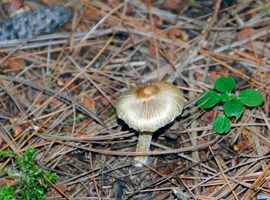
Grows single to scattered on soil in mixed woods
Cap – 1.5 to 3cm, very broadly convex to plane with a prominent pointed umbo, milk chocolate brown, matted long fibers, margin splits in age, dry
Gills – adnexed to slightly sinuate, light gray-tan to medium brown, close to crowded, edges are white and finely serrate
Flesh – white to pale tan, thin
Stalk – central, cylindrical, 3 to 5cm by 3 to 5mm, light to medium tan, fibrous, pithy to hollow
Spore print – milk chocolate brown
Spores – elliptical, smooth, 7-11x4-7 microns
Found July to September; also seen at the Mink River Preserve |
Inocybe fastigiella (Cortinariaceae) no common name
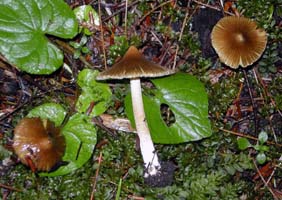 
Grows single to scattered on soil in mixed woods
Grows scattered on soil under conifers or in mixed woods
Cap – 2-3.5 cm, acutely conic, medium brown, fibrous-striate, matted long fibers, margin splits in age, dry
Stem – 3-6 cm by 3-7 mm, central, cylindrical, tapers upward, light brown, cartilaginous, white base
Gills – adnexed to slightly sinuate, tan, close to crowded, broad, white fringed margin
Flesh – tan, thin, green corn odor
Spores – dull brown, elliptical, entire but roughened, 10-15 x 6-7.5 microns
Comments – This has been seen from July to September at The Ridges Sanctuary and Toft Point.
|
Inocybe lilacina (Cortinariaceae) Lilac Inocybe
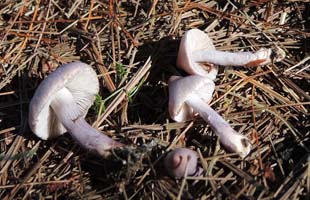
Grows scattered on soil under conifers
Cap – 1.5-2.5 cm, conic to campanulate, pale violet, dull, dry, matted fibers, darker violet umbo
Stem – 3-4 cm by 3-6 mm, central, cylindrical, tapers upward, violet, fibrous-striate, cartilaginous, pithy
Gills – deeply adnexed, close, pale violet to light brown, broad
Flesh – whitish, medium thick
Spores – medium dull brown, elliptical, smooth, 8-9.5 x 4.5-5.5 microns
Comments – These were seen at The Ridges Sanctuary and on private land in September. |
Irpex lacteus (Polyporaceae) Milk-white Toothed Polypore
 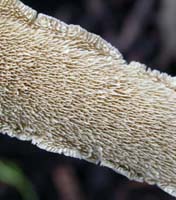
Grows as a continuous coating on the underside of hardwood branches
Fruiting body – white thin leathery coating with a 1-2 cm wide “shelf” with tubes of 1-5 mm length breaking up into flattened teeth on the underside projecting downward; no stalk, flesh is very thin
Pores – 2 per mm
Spores – clear, elliptical to cylindrical, smooth, 5-6 x 2-3 microns
Comments – This was found in October in an upland hardwood. |
Ischnoderma resinosum (Polyporaceae) Resinous Polypore
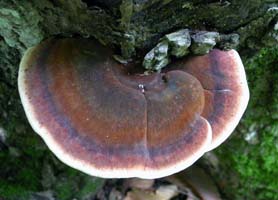 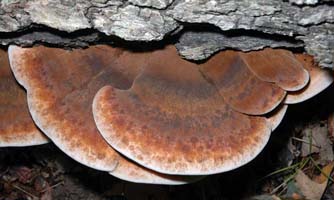  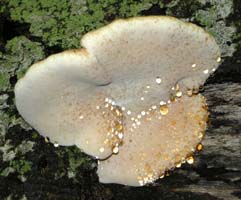
Grows in shelving layers on dead and dying conifer and hardwood trees
Fruiting body – 10-30 cm long by 6-12 cm wide, rosy brown velvety-looking, rounded thick margins, often resupinate-reflexed, zonate with deep-red-orange and black and deep brown bands, tomentose
Underside – off-white to pinkish-white to pale tan, pores – 3-4 per mm
Tubes – medium tan, up to 7 mm deep
Flesh – medium brown, 5-15 mm thick
Spores – white to clear, sausage-shape, non-amyloid, smooth, 5-7 x 1-2 microns
Comments – These have been seen from September to November at the Mink River Preserve, Logan Creek, The Ridges Sanctuary, Peninsula State Park, Whitefish Dunes State Park, Newport State Park, Washington Island and Rock Island. |
Laccaria amethystina (Tricholomataceae) Amethyst Deceiver
 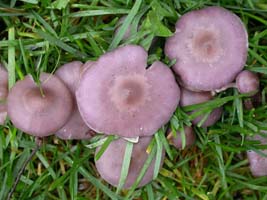 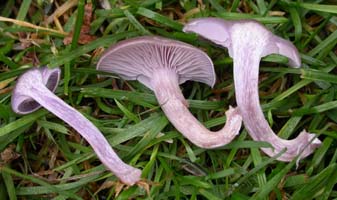
Grows scattered, gregarious or clustered on soil under hardwoods
Cap – 3-5 cm, very broadly convex to plane, umbonate, margin downcurved, dull purple, smooth
Stem – 4-8 cm by 5-10 mm, flexuous, dull purple, cartilaginous, basal white mycelium
Gills – decurrent, sub-distant, purple, broad
Flesh – pale purple, thick only in center, mild odor
Spores – white to buff or pale lilac, fat oval, slightly tuberculate, 6-8 x 4-5 microns
Comments – This was found from late August to late October mainly on private land. |
Laccaria laccata (Tricholomataceae) Common Laccaria
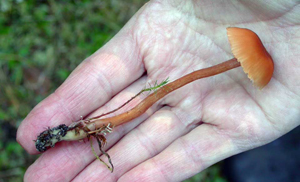 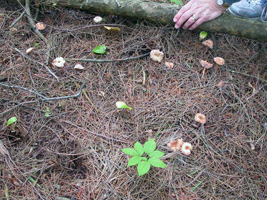 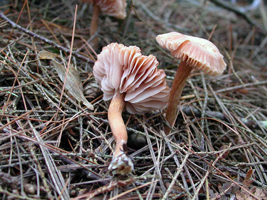 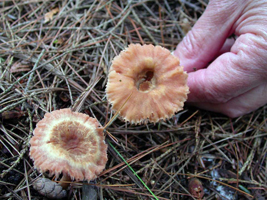
Grows solitary to scattered on soil in mixed woods
Cap – 1.5 to 3 cm, convex, medium orange-brown, smooth, thin eroded striate margin
Gills – Adnexed to sinuate, dull pink, close to sub-distant, very broad, edges eroded
Flesh – Orange-brown to pinkish-tan, medium-thin
Stalk – 5 to 9.5 cm by 2 to 3 mm, medium orange-brown, flexuous, fibrous-striate, pithy-cartilaginous
Spore print – White
Spores – 7-9 microns, nearly round, strongly warted to spiny, non-amyloid
Comments: This is a fairly common species found from mid September to late October and has also been seen at the Rushes Kangaroo Lake trails, Mink River Preserve, Newport Park, Washington Island and other Lake Michigan area woods. |
Lactarius atroviridus (Russulaceae) Dark Green Milk Cap
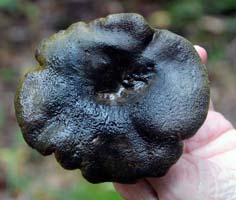 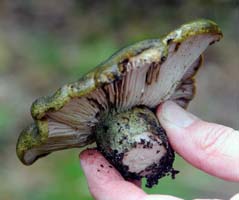
Grows single to scattered on soil in mixed hardwoods, especially oak
Cap – 8-12 cm, very broadly convex with sunken center, very dark green to nearly black in age, margin incurved, tomentose
Stem – 3-4 cm by 2.5-3 cm, central, short and fat, green, Scrobiculate, pithy to hollow
Gills – Adnate, close to crowded, tan in age bruising brown, broad
Flesh – white, medium thick
Latex - white, very acrid taste is slow to develop
Spores – white, amyloid, fat elliptical, reticulate, 6-9 x 6-7 microns
Comments – This is not a common species and was found only once in mid-September on Rock Island. |
Lactarius camphoratus (Russulaceae) Maple Milk Cap
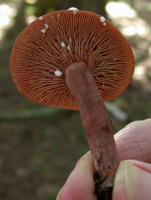
Grows scattered on soil in mixed woods
Cap – 2.5 to 4.5 cm, broadly convex to plane with a blunt umbo, medium cinnamon brown with darker umbo, dry, dull, not viscid, striate or hygrophanous, smooth
Gills – Adnate to short-decurrent, medium tan, close to crowded, narrow
Flesh – Pinkish-brown to pale brown, medium thick, latex white and unchanging, no flavor, distinct maple syrup odor
Stalk – 3 to 4 cm by 4 to 9 mm, tapers downward, dark brown, dry, dull sheen, not viscid, pithy, brittle
Spore print – White
Spores – 6-8 microns, nearly round, spiny, amyloid
Comments: This mushroom is never very large and can blend in with the forest floor due to its reddish-brown color. The best way to sense its maple odor is to wrap several fresh fruiting bodies in a waxed paper bag, store for an hour or so and then smell inside the bag just after opening it. They are found from mid August to early October and have also been seen at the Mink River Preserve and Whitefish Dunes. |
Lactarius deceptivus (Russulaceae) Peppery White Milk Cap
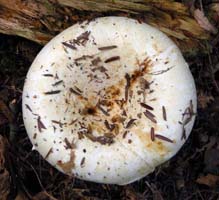  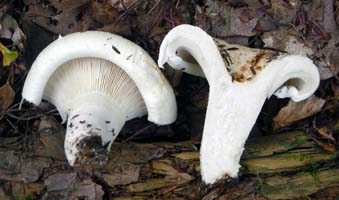
Grows singly on soil in mixed hardwoods and conifers
Cap – 8-12 cm, concave to deep funnel, white with brown stains, incurved margin
Stem – 6-7 cm by 2-3 cm, whitish, tapers downward, fine vertical lines
Gills – adnate to slightly decurrent and a few forked, close, pale yellow-gray
Flesh – white, medium thick, cottony, mild odor
Latex – white, unchanging, acrid taste
Spores – white, amyloid, fat oval to nearly round, spiny, 7-10 microns
Comments – This has been seen in August and September at Whitefish Dunes State Park, Meridian County Park and Rock Island. |
Lactarius deliciosus (Russulaceae) Delicious Milk Cap
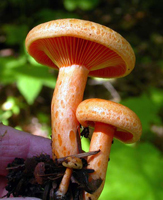 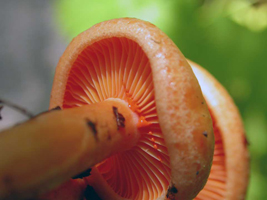 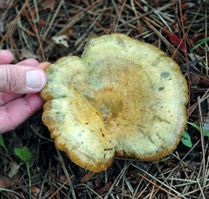
Grows scattered to gregarious on soil in grass or in mixed woods
Cap – 4 to 7 cm, broadly convex with sunken center to a shallow funnel, bright light orange with concentric zoned pattern, margin incurved to uplifted in age, slightly tacky surface
Gills – Adnate to slight decurrent, medium orange, sub-distant, medium broad
Flesh – White but changes quickly to orange due to the orange latex, medium thick
Stalk – 3.5 to 5 cm by 1 cm, central, cylindrical, concolor, slightly mottled or scrobiculate, pithy to hollow, tapers downward
Spore print – Pale yellow to buff
Spores – 8-12 x 6.5-10 microns, nearly round, reticulate, amyloid
Comments: When very fresh this is a beautiful mushroom and will exude copious bright orange latex. It can be found from mid August to mid October and is more common than many other milk caps. It has also been seen Newport State Park and The Ridges Sanctuary. |
Lactarius hibbardae var. hibbardae (Russulaceae) no common name
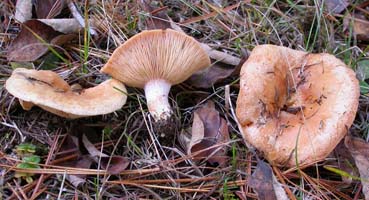 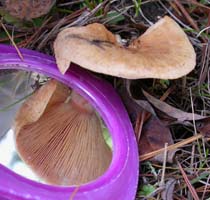
Grows solitary to scattered on grass under maples and pines
Cap – 5-7 cm, concave to shallow funnel shape, pinkish-brown, light yellow-tan uplifted margin, darkest on disk, slightly tomentose on marginal half, hygrophanous
Stem – 2-2.5 cm by 1-1.8 cm at apex and 8-12 mm at base, faint whitish hoary bloom over light pinkish-tan, base is whitish, smooth, pithy to hollow
Gills – adnate to short decurrent, close to crowded, light pinkish-tan, medium-broad
Flesh – concolor with cap margin, moderately thick
Latex - very scant, white and instantly peppery
Spores – white, amyloid, fat oval, spiny, 5-9 x 5-6 microns
Comments – This was first seen on private land in late October 2012 and then again in mid-September 2016. |
Lactarius oculatus (Russulaceae) no common name
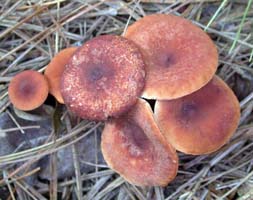 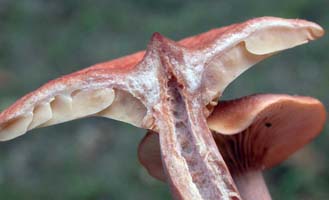 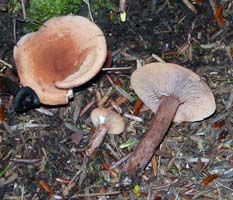
Grows single to scattered on soil under conifers
Cap – 2-3 cm, broadly convex to plane with a small pointed umbo, medium rose brown with darker umbo, dry, smooth
Stem – 2-6 cm by 5-10 mm, central, cylindrical, concolor, dry, smooth pithy to hollow
Gills – adnate to short decurrent, medium pinkish brown, close to sub-distant, medium broad
Flesh – concolor but paler, thick, mild taste
Latex – milky white, soon watery, scant
Spores – white, amyloid, oval to nearly round, spiny, 7-8.5 x 6 microns
Comments – This has been seen in September to early October at Toft Point and Whitefish Dunes State Park. |
Lactarius pubescens var. betulae (Russulaceae) Fuzzy Milk Cap
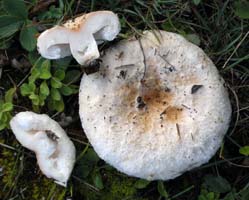 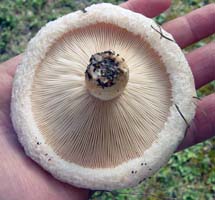 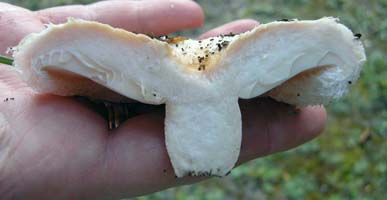
Grows scattered to gregarious on soil or grass in open areas
Cap – 5-8 cm, broadly convex, concave to funneled disk, margin incurved and densely wooly, dingy yellow to orange-tan or pinkish-orange, slightly viscid to tacky
Stem – 1.5-2.5 cm by 1-1.5 cm, concolor, smooth, solid
Gills – adnate to adnexed, pale tan, close to crowded
Flesh – pale tan, thick, very peppery taste
Latex – white, unchanging, very peppery taste
Spores – white, amyloid, oval, spiny-reticulate, 6-8 x 4-6 microns
Comments – This has been found in September into early October in the Mink River Preserve, Washington Island and Rock Island. |
Lactarius quietus var. incanus (Russulaceae) no common name
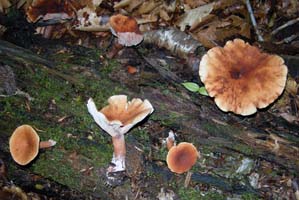 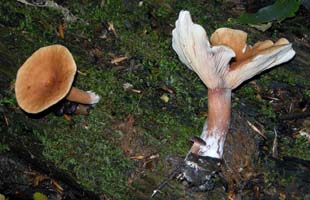
Grows scattered on well-rotted hardwoods like paper birch
Cap – 4-10 cm, plane to slightly concave, becoming funnel shape in age, rich medium orange-brown, margin is paler and has appressed fibers, center is darker and slightly radially grooved
Stem – 4-6 cm by 1-2 cm, central, cylindrical to slightly clavate, medium orange-brown, fibrous-striate, brittle, cartilaginous, pithy to hollow, base has white fur
Gills – adnate to short decurrent, tan, close to crowded, medium-broad
Flesh – light tan, medium thin
Latex – watery-milky, no flavor
Spores – pale yellow, amyloid, fat oval, reticulate, 7-9 x 5-6.5 microns
Comments – This was first seen in mid-September 2016 in the upland hardwoods of the Mink River Preserve. |
Lactarius rimosellus (Russulaceae) no common name
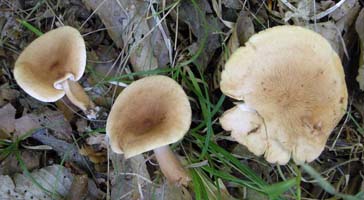 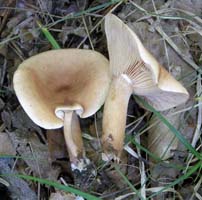 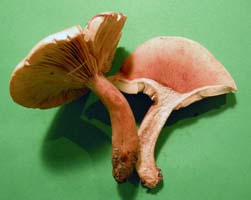
Grows scattered on soil in mixed woods
Cap – 4-7 cm, plane with concave center and a small umbo, very wrinkled around disk, medium-orange to light brown with darker disk, margin downturned
Stem – 3-5 cm by 7-11 mm, central, cylindrical and slightly curved, tapers upward, medium orange-brown, apex is paler, smooth, becoming hollow
Gills – short decurrent by a line, pale orange, close, broad
Flesh – very pale tan, thin, nice odor
Latex – milky, white, unchanging, no flavor, not acrid
Spores – white to very pale buff, amyloid, fat oval, reticulate, 7-9 x 5-6 microns
Comments – This was first found in late September 2016 on the Sugar Bush Trail at Newport State Park. |
Lactarius scrobiculatus var. canadensis (Russulaceae) no common name
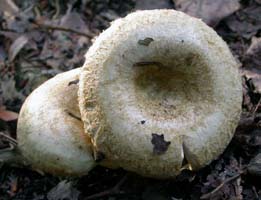  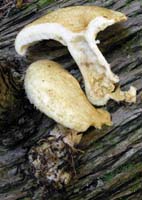 
Grows scattered on soil in mixed woods of conifers and hardwoods
Cap – 8-10 cm, broadly convex with sunken center to small funnel, yellow-tan, tacky to viscid, clumps of light brown matted fibers, margin is hairy and downcurved
Stem – 5-6 cm by 1.5-3 cm, central, clavate to slightly bulbous, tan apex, medium light brown patches, circles and ovals below apex, rigid but hollow
Gills – adnate, pale tan to light yellow, close, very broad
Flesh – white to pale tan, thick, nice odor, mildly acrid (latent)
Latex – yellow immediately and slightly peppery
Spores – white to very pale yellow, amyloid, fat oval, partly reticulate, 7-9 x 5-6 microns
Comments – This has only been seen in the Mink River Preserve in September and early October of 2015 & 2016. |
Lactarius subserifluus (Russulaceae) no common name
 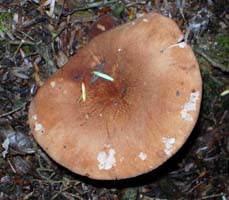 
Grows scattered to gregarious or sub-cespitose on humus, dense leaf litter and moss in mixed woods
Cap – 2-7 cm, broadly convex to slightly concave with a nipple-like umbo, pinkish brown to orange brown, smooth, dry, margin slightly striate in age
Stem – 3-4.5 cm by 3-10 mm, central, cylindrical, pinkish-brown to orange-brown, smooth brittle, pithy to hollow
Gills – adnate to short decurrent, light orange to medium tan, close, broad
Flesh – concolor, thin to medium-thick, pleasant odor
Latex – scant, watery-milky, no flavor
Spores – white, amyloid, nearly round spiny, 6-9 microns
Comments – This has been found from late July to mid-October at Whitefish Dunes State Park, Logan Creek and the Mink River Preserve. |
Lactarius torminosus (Russulaceae) Bearded Milk Cap
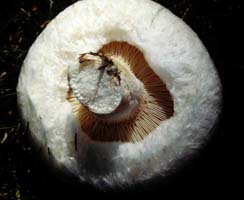 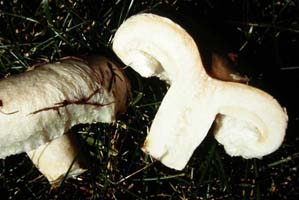
Grows single to scattered on soil in beech hardwoods
Cap – 3-7 cm, plane to funnel shape, margin inrolled and wooly, dull orange concentric bands of light and dark shades
Stem – 2-3 cm by 8-15 mm, tapers downward, pinkish to yellowish, tough, pithy
Gills – adnate to short decurrent, dull orange, close to crowded
Flesh – pale tan, thick, firm
Latex – white, unchanging, watery-milky, latent peppery taste
Spores – white, amyloid, fat oval, spiny-reticulate, 6-9 x 5-7 microns
Comments – This has been seen from late August to early October at the Mink River Preserve, Newport State Park, Whitefish Dunes State Park and Potawatomi State Park. |
Lactarius uvidus (Russulaceae) Purple-staining Milk Cap
 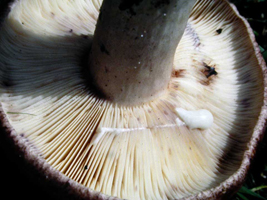
Grows widely scattered on soil in mixed woods
Cap – 4 to 5 cm, Convex to flat with depressed center and tiny umbo, incurved margin, light brownish-gray, smooth
Gills – Adnate to short decurrent, white to pale tan, broad, close
Flesh – White, slowly stains purple when cut, latex creamy white
Stalk – 5 to 7 cm by 1 cm, central, cylindrical, off-white, smooth, dry, pithy to hollow
Spore print – Yellowish-white
Spores – 7.5-11 x 6-8 microns, oval, reticulate, amyloid
Comments: This mushroom is never found in abundance and not seen every year. It has been found from mid August to late September and has also been seen at The Ridges Sanctuary and the Mink River Preserve. |
Lactarius vinaceorufescens (Russulaceae) Yellow-staining Milk Cap
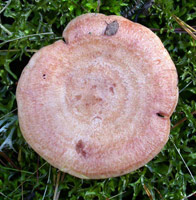  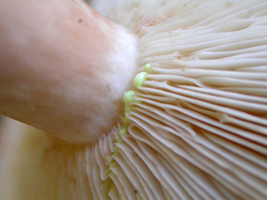
Grows widely scattered on soil in mixed woods
Cap – 2 to 6 cm, broadly convex, sunken center with low umbo, orange-brown, tacky to slightly viscid, smooth
Gills – Adnate, creamy off-white, close to crowded, medium broad, haphazardly forked
Flesh – White, medium thick, milky white latex quickly changes to bright light yellow
Stalk – 3 to 7 cm, pale dull pink-tan, smooth, pithy to hollow
Spore print – White to buff
Spores – 6 to 9 microns, nearly round, spiny, amyloid
Comments: This species has been confused with L. chrysorheus which is a southern species. This is not a real common mushroom, being seen only once every few years. It appears from mid August to mid October and has also been seen at Meridian County Park, Door County Land Trust Kangaroo Lake Preserve and The Ridges Sanctuary. |
Laetiporus sulphureus (Polyporaceae) Sulphur Shelf
 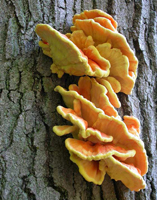
Grows solitary but more often in dense overlapping layers on dead or living hardwoods and conifers
Cap – 5 to 40 cm wide, semicircle to fan shape, bright orange to yellow orange with paler rounded outer margin, surface often wrinkled and bumpy; no stalk
Pore surface – Pale yellow, 2 to 4 pores per mm, pores are difficult to see when very young, darkening with bruising and in age, tubes 1 to 4 mm long
Flesh – Pale yellow, thick, soft and spongy when fresh
Spore print – White
Spores – 5-7 x 3-5 microns, nearly round, entire
Comments: This relatively common species is easily identified due to its brilliant orange color in its wooded habitats. It grows from mid June to late September and has been seen at Peninsula Park and Whitefish Dunes. |
Leccinum aurantiacum (Boletaceae) Aspen Bolete
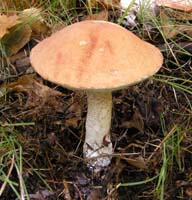 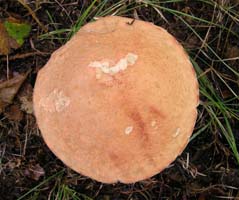  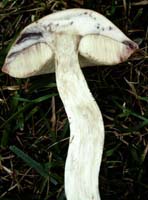
Grows scattered on soil under aspen trees
Cap – 6-12 cm, broadly convex, dull medium brownish orange, dry, smooth
Stem – 12-15 cm by 1.5-3 cm, central, cylindrical, tapers upward, white covered with tiny raised brownish-black clumps of fibers, solid to pithy
Pores – pallid, tiny, round
Tubes – depressed-attached, 1-2 cm deep
Flesh – thick, white, slowly turns reddish than a blue-gray color when cut
Spores – Sand brown, spindle shape, smooth, 12-16 x 4-6 microns
Comments – This can appear quite similar to L. insigne however this turns red before changing to blue when cut. It has been seen in September and October at The Ridges Sanctuary, Mink River Preserve and on private land. |
Leccinum insigne (Boletaceae) Aspen Bolete
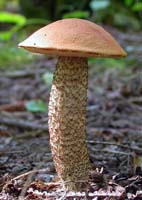  
Grows single to scattered on soil or on wood chips in mixed hardwoods and conifers
Cap – 3-12 cm, hemispheric to broadly convex, medium orange-tan, dull, dry to slightly tacky, smooth
Stem – 8-13 cm by 1.5-3 cm, central, cylindrical, tapers upward, densely coated with clumps of black short fibers over a tan base color, solid, firm, tough, small area at base is a blue-green color
Pores – dull light tan, very tiny, round, bruise black with injury
Tubes – depressed-attached, 10-13 mm long
Flesh – white, up to 13 mm thick, slowly changes to purple-gray color when cut
Spores – medium brown, spindle shape, smooth, 11-16 x 4-6 microns
Comments – This is one species that is often found in late spring when few other mushrooms are found. It has been found from mid-June to October at Newport State Park, Three Springs Preserve and on private land. |
Leccinum scabrum (Boletaceae) Birch Bolete
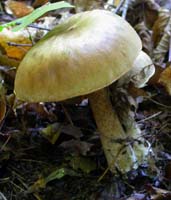  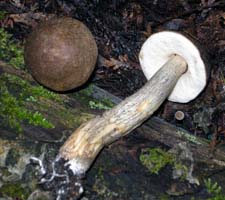
Grows single to widely scattered on soil near paper or yellow birch trees
Cap – 4-9 cm, hemispheric to broadly convex, medium gray-brown to yellow-brown, smooth, dry to slightly tacky
Stem – 6-9 cm by 1-2 cm, central, cylindrical, pale tan with brown dots over much of the surface, blue tints at base, solid to slightly pithy
Pores – dull tan, tiny, round
Tubes – depressed-attached, up to 12 mm long
Flesh – white, very thick, firm, slowly turns bluish-gray when cut
Spores – medium brown, elongated spindle shape, smooth, 15-22 x 5-7 microns |
Lentinellus cochleatus (Tricholomataceae) Cockle-shell Lentinellus
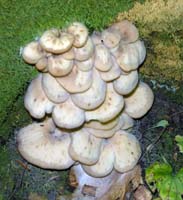   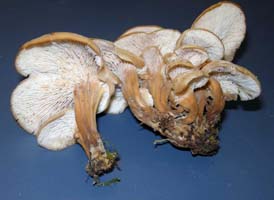
Grows in cespitose clusters at the base of aspen trees
Cap – 4-14 cm, convex to fan-shaped in some growing conditions, light to medium yellow brown, smooth to slightly tomentose near disk, umbilicate, some caps fused at top margins due to crowded growth
Stem – 2-4 cm by 6-10 mm, tapers downward, paler apex, medium brown, smooth, sulcate for most of length, appears corrugated and curled
Gills – adnate to decurrent, tan, serrated edge, broad close to crowded
Flesh – white to tan, very thin
Spores – white, amyloid, fat oval to nearly round, minutely spiny, 3-6 x 4 microns
Comments – The only area these were found was in the Logan Creek Preserve in the upper hardwoods in mid-September 2014. |
Lentinellus ursinus (Tricholomataceae) Bear Lentinellus
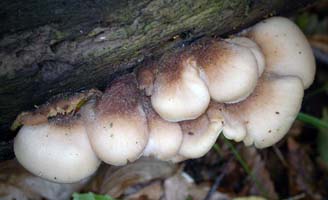  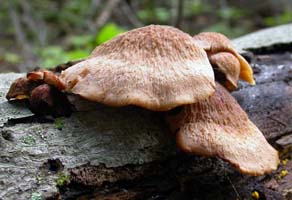
Grows in overlapping layers on fallen dead hardwoods
Cap – 3-6 cm by 2.5-4 cm, shelf-like, light grayish to pinkish tan, deep brown area near attachment has matted fur, downcurved margin is smooth, radially ridged and wrinkled
Stem – 1 cm by 5-8 mm, lateral, tapers to attachment
Gills – decurrent, pale tan, close, jagged edges
Flesh – white to pale tan, thin, tough
Spores – white, amyloid, fat oval to nearly round, minutely spiny, 3.5-5 x 3-4 microns
Comments – The very jagged edges of this make it easy to identify to genus. They have been seen in September at Meridian County Park and on private land. |
Lentinellus vulpinus (Tricholomataceae) Fox Lentinellus
 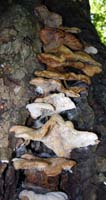 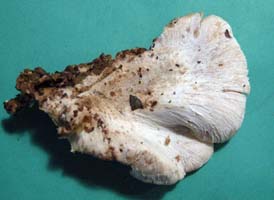
Grows in overlapping layers on dead or dying hardwoods
Cap – 6-9 cm, fan-shaped, chalky white to light tan, dry, rough wrinkled top, margin incurved
Stem – none, merely a lateral attachment of cap to tree
Gills – close to crowded, light tan markedly serrate, broad
Flesh – tan, thin, tough, sour odor
Spores – white, amyloid, nearly round, minutely spiny, 3.5-4.5 x 3-4 microns
Comments – These can be found in September and October at Newport State Park, Mink River Preserve and the Kangaroo Lake Land Trust Preserve. |
Lenzites betulina (Polyporaceae) Birch Gilled Polypore
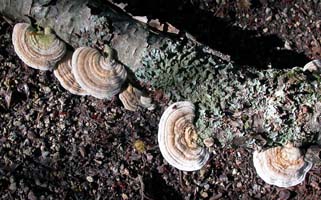 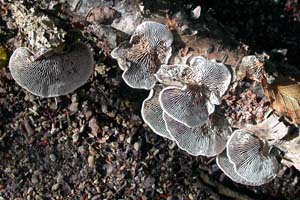
Grows in overlapping layers or clusters on dead hardwoods like birch and beech
Fruiting body – 6-9 cm by 3-5 cm, fan-shaped, concentric furry bands, dull tan and dull orange on top, radially wrinkled; no stem
Underside – blunt-edged gills of varying lengths, close, gray-brown to medium dark brown, up to 1 cm deep, some forked and some broken in a few spots
Flesh – very thin to none, 1mm thick, tan
Spores – white, non-amyloid, cylindrical to sausage shape, smooth, 3-6 x 1-2 microns
Comments – This has been seen from late August to early November at Newport State Park, Mink River Preserve, Peninsula State Park, Washington Island, Logan Creek Preserve and Erskine Woods. |
Leotia lubrica (Leotiaceae) Jelly Babies
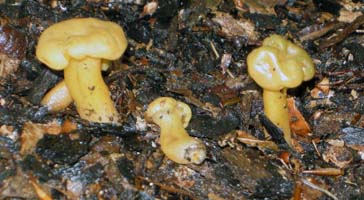
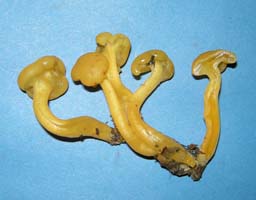 
Grows scattered to gregarious on soil in mixed woods
Fruiting body – 3-5 cm tall, composed of a rounded head and a stem
Head – 1-2 cm wide, very broadly convex, jelly-like, rounded margin and lobes, slightly viscid, dull orange-yellow, smooth top and underside, no gills
Stem – 3-4 cm by 4-10 mm, concolor, central, slightly flattened, minutely pruinose as seen with 10 X lens, hollow, base narrows at the ground
Spores – white, non-amyloid, spindle shape, smooth, 18-25 x 4-6 microns.
Comments – These can go unnoticed if not carefully searching for them. They are found from August to mid-October at Meridian County Park, Whitefish Dunes State Park, Rock Island and Newport State Park. |
Lepiota cepastipes (Lepiotaceae) Onion-stalked Lepiota
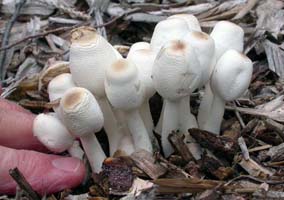  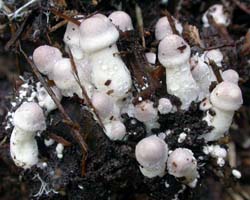 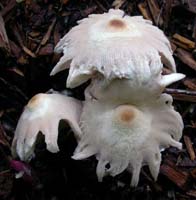
Grows densely clustered on wood chips or well-rotted hardwood
Cap – 2-3.5 cm wide by 2 cm high, oval to convex to bell-shaped in age, white, margin striate, covered with mealy granules which rub off easily, disk is flat and light tan, cap ages light brown to pinkish-brown and splits and flattens out
Stem – 7-8.5 cm by 3-6 mm, central, tapers upward, smooth, very fragile superior ring falls away easily, hollow
Gills – free, white, close to crowded, broad
Flesh – white, thin except on disk, nice odor
Spores – white, dextrinoid, elliptic, smooth, 7-10 x 4-6.5 microns
Comments – This was first discovered on a large pile of wood chips in early September of 2007 and then not seen again until late August of 2011 at Whitefish Dunes State Park. |
Lepiota cristata (Lepiotaceae) Brown-eyed Parasol
 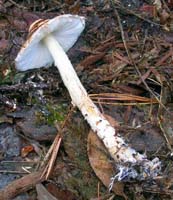 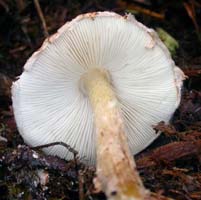 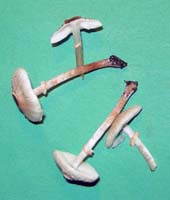
Grows single to scattered on soil in mixed woods under conifers and birch
Cap – 2-4 cm, very broadly convex to bell-shaped, tan with dark brown scales and flat umbo, dry, margin hung with partial veil remnants
Stem – 3-8 cm by 2-9 mm, central, white to light tan, dry, fibrous-striate, small superior ring, tiny basal bulb, pithy to hollow
Gills – free, white, close to crowded, broad
Flesh – white to pale tan, very thin
Spores – white, dextrinoid, bullet shape, smooth, 6-9 x 3-4 microns
Comments – This pretty but poisonous mushroom has been found from August to October at Newport State Park, Whitefish Dunes State Park and Toft Point. |
Leptonia gracilipes (Entolomataceae) no common name
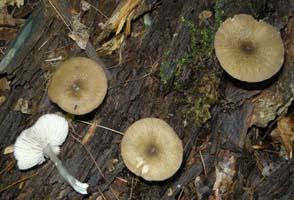 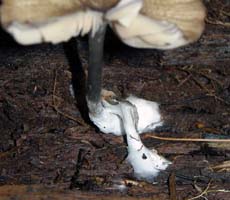 
Grows single to scattered on well-rotted wood in mixed hardwoods
Cap – 1-4 cm, broadly convex and umbilicate, chocolate brown to medium gray brown, tiny brown clumps of raised fibers, striate, margin incurved in youth with dark brown edge
Stem – 3-6 cm by 2-4 mm, central, cylindrical, tan, smooth, cartilaginous, wider base is coated with cottony white mycelial mat
Gills – sinuate to short decurrent, light tan to pinkish, close to sub-distant, broad
Flesh – tan, thin to nearly none
Spores – dull pink, angular with apiculus, entire but roughened, 10-14 x 7-9 microns
Comments – This may be a complex of species but for now will stay with gracilipes. They can be found from late July to early September at The Ridges Sanctuary, Moonlight Bay Bedrock Beach woods, Whitefish Dunes State Park, Washington Island and Newport State Park. |
Leptonia incana (Entolomataceae) Green Leptonia
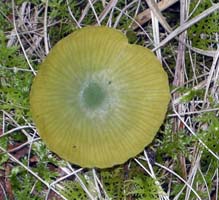   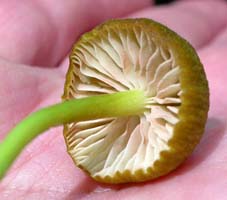
Grows single to scattered on soil, grass or in moss in mixed woods
Cap – 1.5-4 cm, broadly convex to slightly umbilicate, slightly striate downcurved margin, dull green to light yellow-green, disk is darker green, dries to a silky brown
Stem – 2-5 cm by 1-3 mm, central, cylindrical, darker green than cap with some blue tints when handled, smooth, fragile, pithy to hollow
Gills – adnate, pink-tan, close to sub-distant, very broad
Flesh – nearly none
Spores – pink, round-angular, smooth, 9-12 x 7-8 microns
Comments – This is a lovely discovery in the woods and can be seen in September and October at the Mink River Preserve, Newport State Park, Washington Island and Erskine Woods. |
Leptonia serrulata (Entolomataceae) Blue-edged Gills
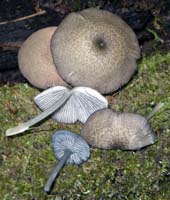 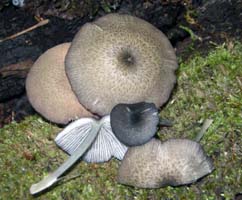 
Grows single to scattered on soil, in moss or on well-rotted wood in mixed wood
Cap – 1-4 cm, very broadly convex to umbilicate, blue-black to gray-brown, scattered dark clumps of fibers
Stem – 3-6 cm by 1.5-4 mm, central, cylindrical, blue-gray, smooth, brittle, pithy to hollow, white basal tomentum
Gills – adnexed to slightly sinuate, grayish to pink-tan with distinct blue-black serrated edges, close
Flesh – nearly none
Spores – dull pink, angular, some 5-sided, 9-12 x 6-8 microns
Comments – This beautiful mushroom can be found from August to late September at The Ridges Sanctuary, Whitefish Dunes State Park, Washington Island, Erskine Woods and Newport State Park. |
Leucoagaricus naucinus (Lepiotaceae) Smooth Parasol
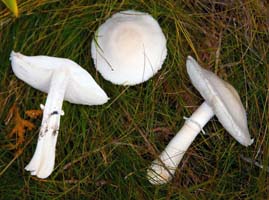 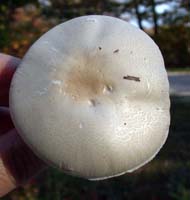 
Grows scattered to gregarious on lawns or in soil under conifers
Cap – 2.5-12 cm, hemispheric to broadly convex, white to pale tan, smooth to finely powdered, dry
Stem – 6-11 cm by 5-17 mm, central, cylindrical, off-white above superior ring, pale tan below ring, white apex, smooth-striate, firm outer rind, narrowly hollow
Gills – free, white, close to crowded, broad
Flesh – white, thick
Spores – white, dextrinoid, elliptical, smooth, 7-10 x 4.5-6 microns
Comments – These can be found in wet weather from August to October at Three Springs Preserve and Rock Island and on private land. Some authors have changed the species to leucothites and moved this into the Agaricaceae family. |
Leucopaxillus albissimus var. lutea (Tricholomataceae) Large Yellow Leucopax
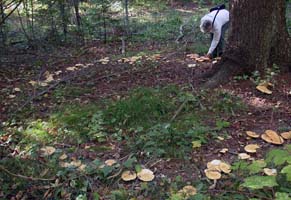 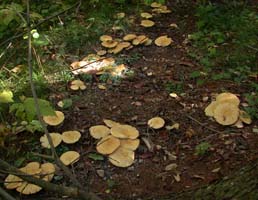 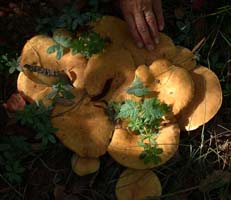
Grows in big fairy ring on soil around a dead white spruce tree
Cap – 2-17 cm, hemispheric to plane in age, rich yellow tan, surface smooth to cracking in age
Stem – 5-6 cm by 13-20 mm, tapers upward, central, cylindrical, light yellowish tan with faint darker streaks, dense mycelial mat at base
Gills – decurrent, light yellow tan, close to crowded, fairly narrow
Flesh – very thick, white, dense, slight sour or unpleasant odor
Spores – white, strongly amyloid, oval to nearly round, spiny or warted, 6-7.5 microns
Comments – This was found only at the Mink River Preserve close to the river in a predominantly conifer woods on 10-1-06. Singer & Smith recognize 12 varieties of this mushroom. I could not find an exact match so made up the variety lutea referring to the yellow colors. |
Lycogala epidendron (Reticulariaceae) Toothpaste Slime or Wolf’s-milk Slime
 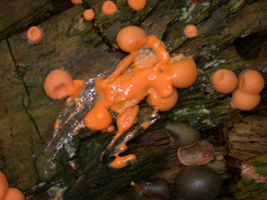
Grows scattered to clustered on dead logs
Fruiting body – 3 to 15 mm in diameter, dull pinkish tan balls with no stalks, filled with pink creamy substance that oozes out when punctured, dries to hard small knobs
Spores – Clear, 6.5 – 7 microns, round, spiny, netted, almost looked double-walled
Comments: This fairly common species grows from August to late October and has also been seen at Kangaroo Lake TNC Preserve, Whitefish Dunes State Park, Newport Park and Rock Island. |
Lycoperdon marginatum (Lycoperdaceae) Peeling Puffball
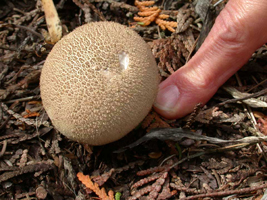 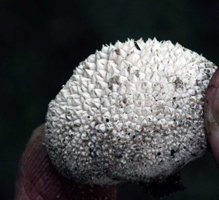
Grows scattered to gregarious on sandy soil in mixed woods
Fruiting body –2 to 4 cm tall by 3 to 5 cm wide, off white, densely covered with pyramid-like hairy tipped warts which peel off in sheets at maturity leaving a tan smooth undersurface
Spores – Olive brown, 4-5 microns, round, minutely warted or spiny
Comments: These grow from early September to mid October and have also been seen at the Ridges Sanctuary and Whitefish Dunes State Park. It is also know as Lycoperdon candidum. |
Lycoperdon perlatum (Lycoperdaceae) Gem-studded Puffball
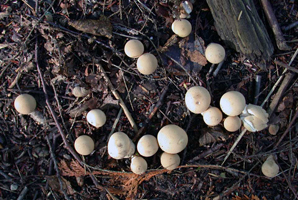 
Grows solitary to scattered or clustered on soil in open woods often under conifers
Fruiting body – 3 to 6 cm tall by 2 to 3 cm wide, medium yellow tan to gray tan, top is often turban shaped with a 1.5 to 2 cm wide stalk that is 2 to 3 cm long. Top has 1 mm high pointed scales that rub off leaving tiny golf ball-like surface indentations.
Spores – Medium brown, 3-4 microns, spiny or finely warted
Comments: This fairly common species grows from late August to late October and has also been seen at Mink River, Peninsula Park, Rock Island and Whitefish Dunes. |
Lycoperdon pyriforme (Lycoperdaceae) Pear-shaped Puffball
 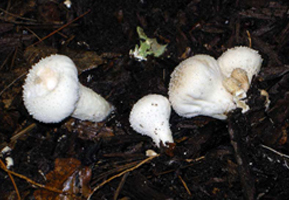
Grows scattered to gregarious on rotting hardwood logs and stumps
Fruiting body – 2 to 3 cm tall by 2 cm wide, tan to medium brown, pale tan narrowed base, top has fine upright points widely spaced on the surface
Spores – Brown, 3.5-4.5 microns, round, smooth
Edibility – See L. marginatum, tasteless
Comments: This very common species grows from mid August to late October and has also been seen at Newport Park, Peninsula Park, Washington Island, Rock Island, Whitefish Dunes, Mink River and Kangaroo Lake Preserve. |
Lyophyllum connatum (Tricholomataceae) Fried Chicken Mushroom
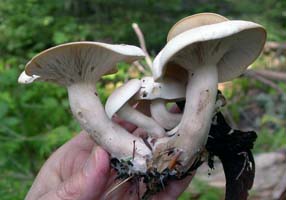 
Grows clustered on soil along roadsides or in woods; can grow single to scattered as well on lawns
Cap – 3-7 cm, very broadly convex to plane, margin uplifted in age, off-white to gray tan, paler margin, smooth
Stem – 3-6 cm by 8-15 mm, central, cylindrical, white apex, light gray tan lower half, silky fibrous-striate, tough and firm but brittle, pithy
Gills – adnate to short decurrent, white, close to crowded
Flesh – white, thick, solid, no flavor, no distinctive odor
Spores – white, non-amyloid, nearly round, smooth, 4-6.5 microns
Comments – These often grow in dense cespitose clusters on driveways but can also grow single to scattered. They are found in August and September at the Mink River preserve and on private land. |
Lyophyllum decastes (Tricholomataceae) Fried Chicken Mushroom
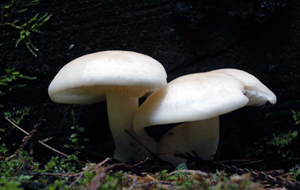 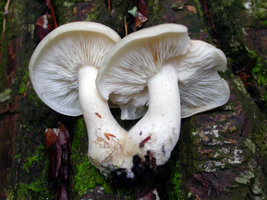  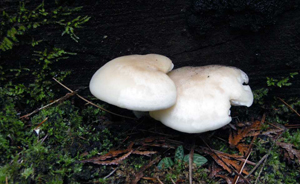
Grows scattered to clustered on soil in mixed woods
Cap – 4 to 9cm, broadly convex, white to pale tan, smooth, incurved margin
Gills – sinuate, concolor, broad, close to crowded
Flesh – white, thick, firm
Stalk – central, cylindrical, 4 to 7cm by 1 to 2cm, tapers upward, concolor, slightly hairy as seen with 10 X lens, bulbous hairy base, solid to very slightly pithy, cartilaginous rind
Spore print – white
Spores – round, non-amyloid, smooth, 3-4.5 microns
Found in fall; also seen in The Clearing School woods |
Marasmius androsaceus (Tricholomataceae) Horsehair Fungus
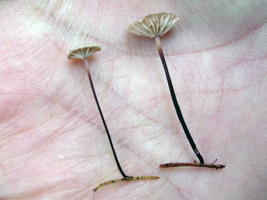 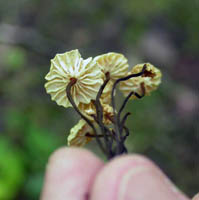
Grows gregariously on fallen spruce needles
Cap – 5 to 10 mm, convex with slightly depressed center, white
Gills – Adnate, white to cream, sub-distant, intervenose
Flesh – Little to none
Stalk – 3 to 4 cm by .5 mm, central, dark brown, wire-like
Spore print – White, but often difficult to obtain
Spores – 6-9 x 2.5-4.5 microns, elliptical, entire, non-amyloid
Edibility – Not edible; too tough and too small
Comments: This species is difficult to find as each fruiting body is attached to one fallen spruce needle lying on the dark ground. They appear from early July to late September and have also been seen at The Ridges Sanctuary. |
Marasmius capillaris (Tricholomataceae) Dead Leaf Marasmius
 
Grows gregariously in troops on dead beech leaves in a mixed woodland
Cap – 5-13 mm, hemispheric to broadly convex, almost plane in age, white but dries to a tan color, umbillicate, sulcate-striate, dry, shrivels in dry weather and revives with rain
Stem – 3-3.5 cm by .5 mm, central, wiry, black, paler apex, smooth
Gills – adnate to free, attached to a small collar, distant, white, turning tan with age, broad
Flesh – nearly none
Spores – white, non-amyloid, elliptical, smooth, 6-9 x 3-4 microns
Comments – These can be overlooked in dry weather, but after substantial rains they appear in masses on dead leaves, either beech or oak. These were seen in mid-September on Rock Island. |
Marasmius cohaerens (Tricholomataceae) Fused Marasmius
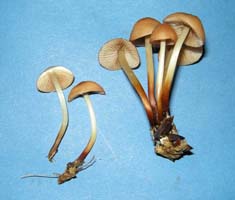
Grows scattered to clustered on leaf litter in mixed hardwoods
Cap – 1.5-4 cm, broadly convex to plane, low umbo, medium yellow brown with darker umbo, dry, smooth, hygrophanous
Stem – 5.5-9.5 cm by 2-3 mm, central, sometimes curved, apex white grading to dark brown base, smooth, polished appearing, rigid, pithy to hollow
Gills – adnexed to nearly free, light tan, close, medium broad
Flesh – dull tan, thin, acrid smell
Spores – white, non-amyloid, elliptical, smooth, 7-8 x 3-4 microns
Comments – These can be found from late August to early October in mixed hardwoods and have only been seen on private property. |
Marasmius oreades (Tricholomataceae) Fairy Ring Mushroom
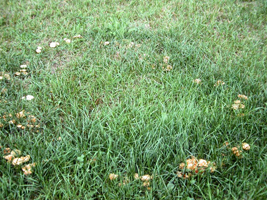 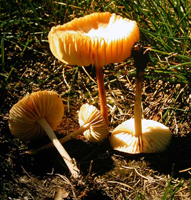 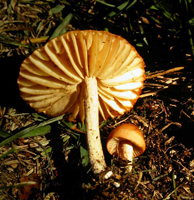
Grows gregariously or in fairy rings in grassy areas
Cap – 2 to 4 cm, broadly convex with a low umbo, yellow-tan, smooth, hygrophanous, not striate, slightly scurfy surface on umbo
Gills – Adnexed to nearly free, tan, sub-distant, broad
Flesh – White to pale tan, thick, unpleasant acrid odor
Stalk – 4 to 6 cm by 3 to 5 mm, pale tan, central and cylindrical, tapers downward, tough, solid to pithy, smooth apex, scurfy base
Spore print – White
Spores – 6-8.5 x 4-6 microns, oval, entire, non-amyloid
Comments: This mushroom is quite common in many parts of Door County where large grassy areas exist. At Toft Point it has been found in the west end of the old field and east of the barn. It appears from early August through late September. |
Marasmius rotula (Tricholomataceae) Little Wheel Marasmius
 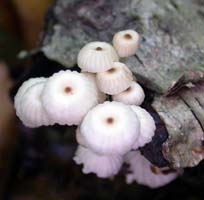 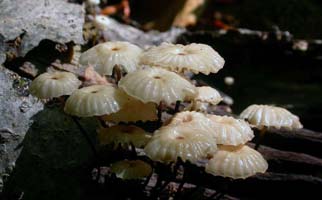 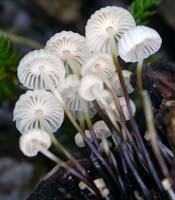
Grows scattered to clustered on well-rotted hardwood or in moss at the base of hardwood trees
Cap – 5-12 mm, broadly convex to plane in age, white to very pale tan, umbilicate with black center, striate to sulcate-striate
Stem – 2-8 mm by .5-1.5 mm, central, wiry, dark brown to black fading to white at apex, smooth, tough
Gills – white, distant, attached to a collar which stands away from the stalk, broad
Flesh – little to none
Spores – white, non-amyloid, elliptic, smooth, 7-10 x 3.5-4.5 microns
Comments – These can be found through much of the summer if it is a wet season. They dry up in droughts and then revive with adequate rain. These have been found at Whitefish Dunes State Park, mink River Preserve, Death’s Door Bluff County Park, Bjorklunden Woods and Newport State Park from early July to late September. |
Marasmius siccus (Tricholomataceae) Mini Pink Parasol
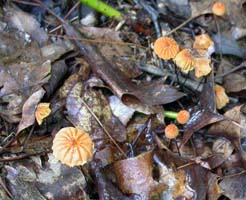 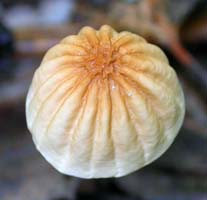 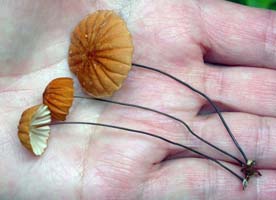 
Grows scattered to gregarious on rotting leaves in mixed woodlands
Cap – 2-3 cm, hemispheric to broadly convex, orange to pinkish, fading in age, sulcate-striate, disk sometimes wrinkled
Stem – 5-8 cm by .5-1cm, central, black, wiry, tough
Gills – nearly free, light tan to pinkish-tan, distant
Flesh – nearly none
Spores – white, non-amyloid, smooth, spindle shape to cylindrical, 12-19 x 4-5 microns
Comments – These are a delight to find in the woods when freshly growing, looking like tiny pink-orange umbrellas. They can be found from early July to late September and have been seen at Whitefish Dunes State park, Death’s Door Bluff County Park and Rock Island. |
Marasmius strictipes (Tricholomataceae) no common name
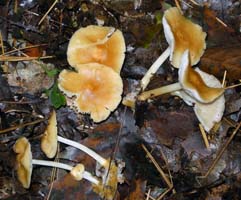 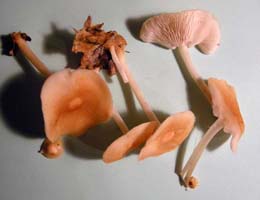
Grows single to scattered on dead leaves in mixed woodlands
Cap – 1.5-5 cm, convex in youth to plane or concave in age with uplifted margins, broad low umbo, deep yellow, paler margin, darker umbo, smooth, hygrophanous
Stem – 5-6 cm by 3-6 mm, central, cylindrical, smooth, white to pale tan, cartilaginous, hollow, tough
Gills – adnexed to slightly sinuate, white, close to crowded, medium-broad
Flesh – dull medium yellow, water-soaked
Spores – white, non-amyloid, elliptical, smooth, 6-9 x 3-4 microns
Comments – This was first discovered in mid-October of 2016 in Newport State Park in the far northeast section. |
Melanoleuca alboflavida (Tricholomataceae) Yellowish-white Melanoleuca
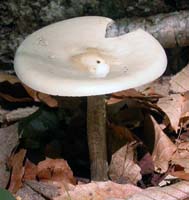 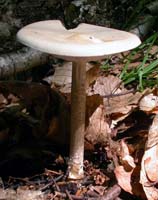 
Grows single to scattered on dead leaves in mixed woodlands
Cap – 1.5-5 cm, convex in youth to plane or concave in age with uplifted margins, broad low umbo, deep yellow, paler margin, darker umbo, smooth, hygrophanous
Stem – 5-6 cm by 3-6 mm, central, cylindrical, smooth, white to pale tan, cartilaginous, hollow, tough
Gills – adnexed to slightly sinuate, white, close to crowded, medium-broad
Flesh – dull medium yellow, water-soaked
Spores – white, non-amyloid, elliptical, smooth, 6-9 x 3-4 microns
Comments – This was first discovered in mid-October of 2016 in Newport State Park in the far northeast section. |
Merulius tremellosus (Corticiaceae) Trembling Merulius; Dry Rot Fungus
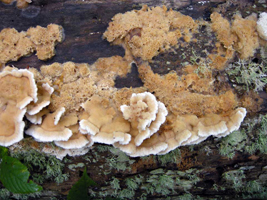 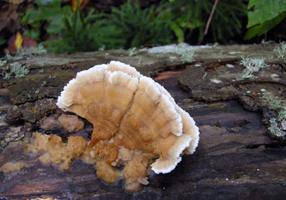 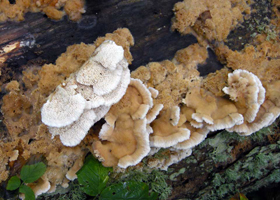
Grows as multiple shelving masses on dead hardwood, especially American Beech
Fruiting body – 5cm by 3cm (average), tan, one zone is radially wrinkled and other sections are smooth, margin is hairy and whitish, dull color, soft and flexible when fresh
Fertile surface (underside) – very light tan, darker near attachment, labyrinth-pored and toothed, teeth up to 5mm long, one layer, pores 2 per mm
Flesh – tan, thin
Spore print – white or clear
Spores – sausage-shaped, smooth non-amyloid, 6-8.5x1.5-2.5 microns
Found in September; also seen at Whitefish Dunes State Park |
Microglossum rufum (Geoglossaceae) Flat-headed Earth Tongue
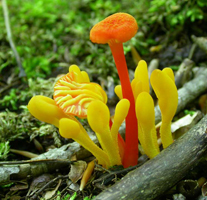
Grows scattered to clustered on well-rotted wood or buried wood in mixed forests
Fruiting body – 3 to 4.5 cm tall, head is 5 to 10 mm wide and 1 to 1.5 cm tall, deep yellow to yellow-orange, spoon-like and slightly compressed head
Flesh – Thin and brittle
Stalk – 2 cm tall by 2 to 4 mm wide, concolor, scurfy-scaly near apex
Spores – Clear, 30-47 x 5-7 microns, entire, look like long skinny bananas
Comments: This uncommon species grows from mid July to late September and has also been seen at Meridian County Park, Mink River, Newport Park and The Ridges Sanctuary. |
Morchella esculenta (Morchellaceae) Yellow or Tan Morel
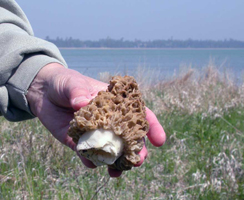 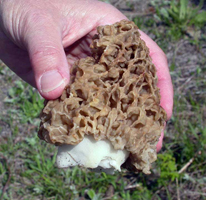 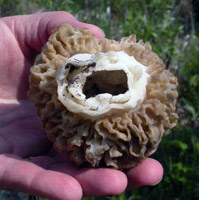
Grows solitary to scattered on soil in open woods or fields
Cap – 4 to 12 cm tall by 2 to 5 cm wide, oval to slightly irregular shape, yellow-brown to tan, pits roundish to irregular not as vertically set as in the black morel
Flesh – little to none
Stalk – 1 to 6 cm tall by 1 to 3 cm wide, light tan, hollow and confluent with the lower edge of the cap, finely granular surface, equal or enlarged at base
Spores – Clear, 17-24 x 9-14 microns, elliptical, entire
Comments: This species is rather rare at Toft Point. It grows in May to early June and has been found in many other areas of Door County. |
Mycena alcalina (Tricholomataceae) Alkaline Mycena
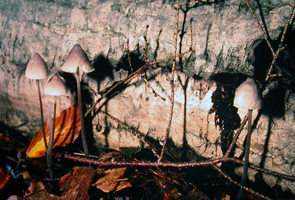
Grows in clusters on well-rotted conifer wood
Cap – 2 to 4 cm, conic to bell-shaped aging to nearly flat, low umbo, dark gray when young fading to pale gray or gray-brown, smooth, striate
Gills – Adnate to slightly decurrent, grayish-white, close, broad
Flesh – Gray, thin, odor like bleach
Stalk – 3 to 6 cm by 1.5 to 2.5 mm, pale gray, smooth, fragile, hollow
Spore print – White
Spores – 7-9 x 5 microns, elliptical, entire, strongly amyloid
Comments: This is a very uncommon species, recorded only once at Toft Point by Veronica Pavlat in the fall of 1983. It has also been seen at the Mink River Preserve. |
Mycena atroalboides (Tricholomataceae) No common name
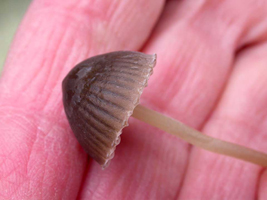 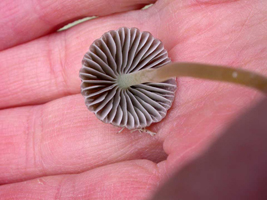
Grows solitary to scattered on soil near rotted conifers
Cap – 1 cm tall by 1.7 cm wide, hemispheric, medium brown, dry, no sheen, smooth, strongly striate halfway to center of cap
Gills – Adnate, gray, sub-distant, broad
Flesh – Gray, thin
Stalk – 7.5 cm by 1 to 2 mm, white apex, light gray-brown lower half, central, curved, smooth, pithy to hollow
Spore print – White
Spores – 8-10 x 4-6 microns, oval, entire, amyloid
Comments: Very rare; seen only once at Toft Point in October 2006 and one time at Whitefish Dunes on 10-12-95. |
Mycena capillaris (Tricholomataceae) Miniscule Mycena
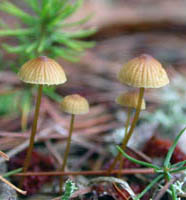  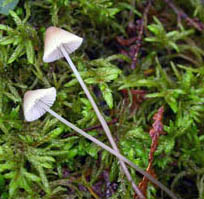
Grows scattered on soil or in moss under conifers or mixed woods
Cap – 5-7 mm, conic to bell-shaped, broad umbo, dull, dry, soft light gray-brown, darker center, striate
Gills – Adnexed, light tan, broad, close to sub-distant, not emarginate
Flesh – little to none
Stalk – Central, cylindrical, 2.5-6 cm x 1 mm, medium-tan, smooth, white hairs at base
Spore print – White
Spores – Elliptical, entire, non-amyloid, 8-9 x 3.75-4.5 microns
Comments: this very slender tall mushroom can be missed if you walk by too fast; it is found in September and October |
Mycena pura (Tricholomataceae) Lilac Mycena
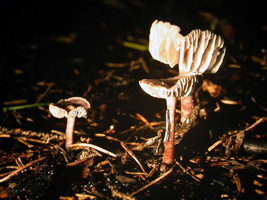
Grows solitary or clustered on soil in mixed woods
Cap – 1.5 to 4 cm, broadly convex to nearly flat with a lightly tomentose (fine hairs) low umbo, margin smooth, dry, hygrophanous
Gills – Adnate to short decurrent, dull lilac, no dark edges, sub-distant, very broad
Flesh – White to very pale lilac, very thin, radish odor
Stalk – 7 cm by 2-3 mm, central, white to pale lilac, hairy base, smooth, hollow
Spore print – White
Spores – 5-10 x 3-5 microns, elliptical, entire, amyloid
Comments: This is never abundant being reported only once at Toft Point by Veronica Pavlat in the fall of 1983. It can be found mostly in September to mid October and has also been seen at Mink River Preserve, Washington Island and Whitefish Dunes State Park. |
Mycena subcana (Tricholomataceae) Neutral Gray Mycena
 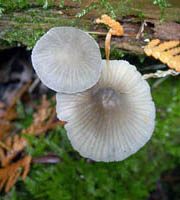  
Grows scattered on soil or in moss under conifers
Cap – 1.5-2 cm, conic to bell-shaped, gray-brown, smooth, dry, striate margin is pale gray
Gills – Adnate, pale gray, broad, close to sub-distant, not emarginate
Flesh – White, very thin
Stalk – Central, cylindrical, 3-7 cm x 1-3 mm, apex is pale gray, rest is medium gray with a very hairy base, smooth, fragile, pithy to hollow
Spore print – White
Spores – Elliptical, smooth, amyloid, 8-11 x 5-7.5 microns
Comments: Found from September to early November, also seen at Whitefish Dunes State Park and Meridian County Park |
Naematoloma sublateritium (Strophariaceae) Brick Tops
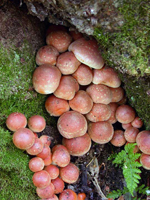 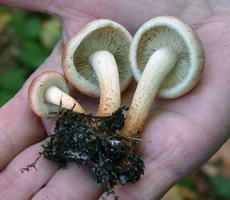 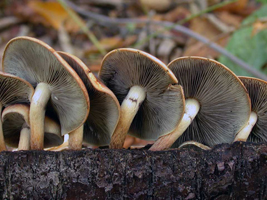
Grows scattered to cespitose on fallen hardwoods, mainly paper birch
Cap – 3 to 5 cm, hemispheric to convex becoming flat in age, medium yellow brown to orange brown, faintly furry, hygrophanous, margin incurved at first
Gills- Sinuate or adnate to short decurrent, close to crowded, pale tan when young, gray when mature, very broad
Flesh – Tan to medium brown, medium thick
Stalk – 4 to 6 cm by 4 to 8 mm, pale tan apex, rest is medium brown to dark brown base, tough, pithy to hollow, fibrous striate
Spore print – Purple brown
Spores – 6-8 x 3-4 microns, oval, entire
Comments: This fairly common species is found growing from early September to late October. It has also been seen at Newport State Park and Whitefish Dunes. Another genus name is Hypholoma. |
Onnia tomentosa (Polyporaceae) Wooly Velvet Polypore
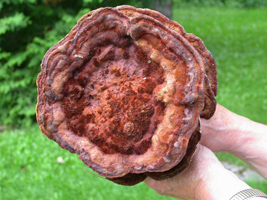 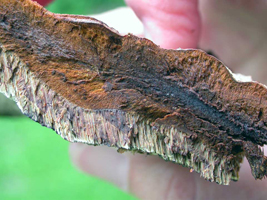 
Grows on ground or well-rotted wood in mixed woods
Cap – 8 to 18cm wide, broad shallow funnel up to 9cm tall, deep yellow-brown to medium-dark chocolate brown, concentric rings of color, tomentose, paler undulating margin
Pore surface – decurrent, light to medium tan, pores 3 to 4 per mm
Tubes – 2 to 5 mm deep, single layer
Flesh – medium-thick, medium brown, 3 to 5mm thick, satiny appearance
Stalk – central, cylindrical, 3 to 4cm tall by 2 to 5cm wide, dark brown, tomentose, tough, solid
Spore print – white
Spores – elliptical, smooth, 5-7x3.5-4.5 microns
Comments: Old name is Inonotus tomentosus. Found in fall; also seen at Newport State Park |
Otidea auricula (Pyronemataceae) no common name
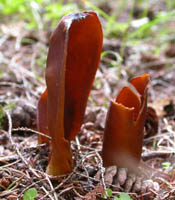 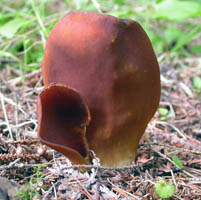 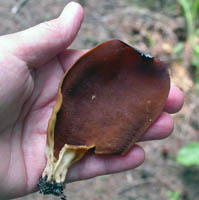
Grows scattered to clustered on soil under conifers
Fruiting body an upright cup-like structure with a short stalk, curved fertile inner side is a rich deep chocolate brown with a dull matte surface; outer surface is slightly paler with a dull sheen
Size – 6-9 cm tall x 2.5-5 cm wide
No gills
Flesh – whitish, thin, brittle
Stalk – 2 cm x 8-12 mm, light tan with edges curled and almost meeting
Spores – Clear, entire, oval, 18-24 x 12-16 microns
Comments: found in June on trail leading to east edge of old field; area is now covered by large fallen Eastern Hemlock; also known as Helvella silvacola and Wynnella silvacola |

